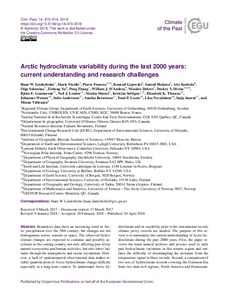Arctic hydroclimate variability during the last 2000 years: current understanding and research challenges
Hans W. Linderholm; Minna Väliranta; Elizabeth K. Thomas; Dmitry V. Divine; Tomi P. Luoto; Annika Berntsson; Konrad Gajewski; Zicheng Yu; Pierre Francus; Neil J. Loader; Samuli Helama; Atte Korhola; Sofia Andersson; Peng Zhang; Olga Solomina; Johannes Werner; Maxime Debret; Nicolas Massei; Marie Nicolle; Kristina Seftigen; Björn E. Gunnarson; Saija Saarni; William J. D'Andrea; Liisa Nevalainen
https://urn.fi/URN:NBN:fi-fe2021042718966
Tiivistelmä
Reanalysis data show an increasing trend in
Arctic precipitation over the 20th century, but changes are not
homogenous across seasons or space. The observed hydroclimate changes
are expected to continue and possibly accelerate in the coming century,
not only affecting pan-Arctic natural ecosystems and human activities,
but also lower latitudes through the atmospheric and ocean circulations.
However, a lack of spatiotemporal observational data makes reliable
quantification of Arctic hydroclimate change difficult, especially in a
long-term context. To understand Arctic hydroclimate and its variability
prior to the instrumental record, climate proxy records are needed. The
purpose of this review is to summarise the current understanding of
Arctic hydroclimate during the past 2000 years. First, the paper reviews
the main natural archives and proxies used to infer past hydroclimate
variations in this remote region and outlines the difficulty of
disentangling the moisture from the temperature signal in these records.
Second, a comparison of two sets of hydroclimate records covering the
Common Era from two data-rich regions, North America and Fennoscandia,
reveals inter- and intra-regional differences. Third, building on
earlier work, this paper shows the potential for providing a
high-resolution hydroclimate reconstruction for the Arctic and a
comparison with last-millennium simulations from fully coupled climate
models. In general, hydroclimate proxies and simulations indicate that
the Medieval Climate Anomaly tends to have been wetter than the Little
Ice Age (LIA), but there are large regional differences. However, the
regional coverage of the proxy data is inadequate, with distinct data
gaps in most of Eurasia and parts of North America, making robust
assessments for the whole Arctic impossible at present. To fully assess
pan-Arctic hydroclimate variability for the last 2 millennia, additional
proxy records are required.
Kokoelmat
- Rinnakkaistallenteet [19204]
